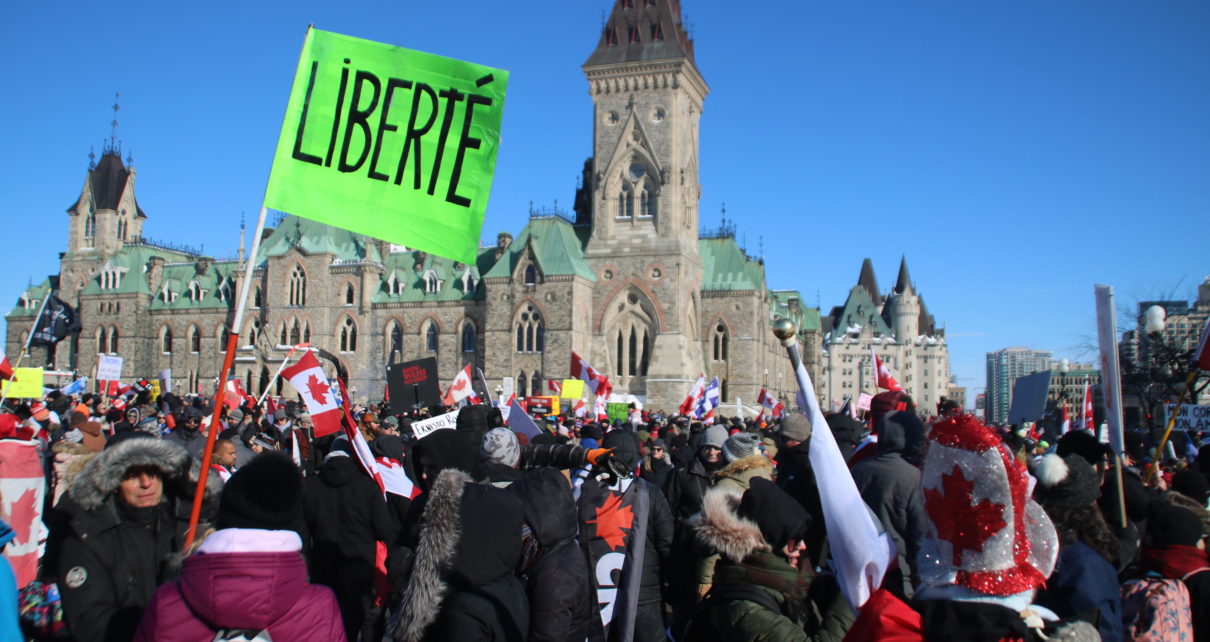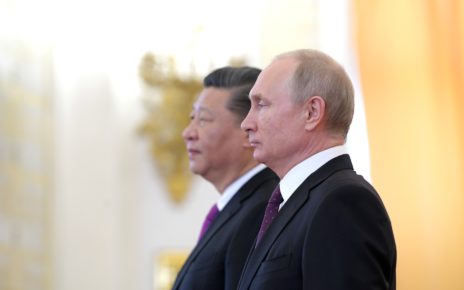While the “Freedom Convoy”’ has disappeared from Parliament Hill, its legacy was still physically visible during Ottawa’s most recent Canada Day celebration. In anticipation for the possibility of another occupation attempt, several downtown streets were barricaded and police were on heightened alert throughout the weekend. The protest’s legacy also remains widely apparent online as the divergent grouping of white supremacist organizations, QAnon conspiracy theorists, far-right figures, and anti-vaccine advocates that briefly dominated the capital during the winter continue to network using platforms, such as the encrypted messaging app Telegram. The continued activity of these individuals highlights the role of disinformation in accelerating individual dissatisfaction into a radicalized form of mass grievance politics, a process that poses a significant threat to Canada.
Beginning on the west coast of British Columbia in late January, the “Freedom Convoy” eventually occupied much of downtown Ottawa and other key checkpoints along the US-Canada border until removed by police. Initially sparked by a desire to end pandemic-related health restrictions across the country, the convoy became a full-fledged protest against the broader legitimacy of the federal government with several protest leaders endorsing petitions calling on Prime Minister Justin Trudeau to be removed from power. During this period, the protestors, under the guidance of several former military personnel, also maintained a large and well-organized camp around Parliament Hill while raising millions of dollars across various crowd-funding platforms.
In the initial weeks following the Ottawa protests, several roadblocks were also erected along the border, including in Coutts, Alberta and along the Ambassador Bridge between Windsor and Detroit, forcing auto manufacturers Ford, Chrysler, and Toyota to shutter production lines in surrounding cities. In Coutts, an RCMP raid of the blockade also revealed that an unidentified element within the encampment were also heavily armed with handguns, long guns, body armor, and a significant stockpile of ammunition. These arrests, while potentially preventing acts of violence, also highlights the malleability of the movement’s aims, a tactic that has allowed it to remain relevant within Canadian society.
While the convoy protests were initially designed to pressure the federal government to rescind its COVID-19 restrictions on the grounds of protecting individual liberty, particularly its requirement that international travelers be vaccinated prior to entry, the movement rapidly became inundated with pandemic-related disinformation, along with related grievances. Though significantly varied, these narratives often allege that the virus was non-biological in its origins, whether having been created by Bill Gates, related to the World Economic Forum, or that the pandemic itself was fictitious. Many protestors, spurred by civic-related disinformation, also called the Governor General’s office to demand that the Governor General dissolve Parliament, while also stating that they were interested in directly joining a coalition government with the Conservatives, Bloc Québécois, and New Democratic Party to oust the Liberals.
These false claims, used in part to justify the movement’s demand for Justin Trudeau’s resignation, primarily emerged from prominent social media personalities within both the Canadian and American right, including those associated with the QAnon conspiracy and the Yellow Vest Canada movement. These narratives were routinely repeated across platforms such as the app Telegram and a constellation of sympathetic media organizations, forming an “echo chamber” around convoy participants that incentivized their continued occupation. Further, this “echo chamber” has continued to expand since the protest ended, as evidenced by many of the protestors shifting their focus to the war in Ukraine and their vocal acceptance of Russia’s version of the conflict.
The protest ultimately came to an end after both the provincial government of Ontario and the federal government–acting under the Emergencies Act–cleared the protestors from Ottawa and their other encampments across the country. However, rather than dissolving entirely, even after the arrest of several of its leaders, the movement has continued to flourish, representing a persistent national security concern. The ability of the protestors, inspired by particularly virulent forms of disinformation, to enter Ottawa relatively unchallenged and occupy the physical heart of Canada’s government while simultaneously disrupting its most critical economic relationship for weeks highlights the vulnerability of Canada’s democracy to other radicalized mass movements. Further, the effectiveness of the “Freedom Convoy” protests in sowing chaos across the country has also harmed Canada’s image as a largely peaceful “middle power,” inadvertently damaging the image of democracy as an effective form of government, a key focus of authoritarian regimes’ disinformation campaigns. The relatively sudden emergence of the convoy as a potent political force also highlights the latent acceptance of such opinions within mainstream society and the willingness of believers to act upon these views, representing a penetration of disinformation into Canadian public life that may be weaponized by an adversary in the future.
Protests will always remain integral to the functioning of a democracy, even when they may pose an undue burden on the surrounding community. Nor will complex policy responses to intricate crises become less controversial within a society as diverse as Canada, particularly not crises as all-encompassing as the coronavirus pandemic. However, the “Freedom Convoy” and its variants highlight not merely the “why” but also the “how” of the threat posed by disinformation to Canada, particularly in revealing how disinformation may accelerate the integration of mass grievance politics and individuals’ lived experience. Believing that the government of Canada has erred in its handling of the pandemic is a common behaviour, while actively seeking to overthrow a democratically elected government is not. The danger faced by Canada, and other democracies, is that disinformation is increasingly bringing these two impulses together.
Image copyright: “Manifestation contre l’imposition de la vaccination obligatoire pour les camionneurs à Ottawa” by Véronic Gagnon via Wikimedia. Licensed under CC BY 4.0.
Disclaimer: Any views or opinions expressed in articles are solely those of the authors and do not necessarily represent the views of the NATO Association of Canada.




